Speech The Evolving Risk Environment

Malcolm Edey[*]
Assistant Governor (Financial System)
Australian Shareholders Association (ASA) Investor
Forum
Sydney –
- Audio 29.4MB
- Q&A Transcript
Thanks for the opportunity to speak to you today. I have taken as my subject ‘the evolving risk environment’.
As you know, the Reserve Bank has a longstanding mandate to promote financial stability. The way we interpret that mandate, its place in the wider central banking framework, and its interaction with the mandates of the other financial regulators, are large topics in themselves.[1] For today, I simply note that one of the ways we seek to promote financial stability is by providing regular analysis of system risks, particularly through our half-yearly Financial Stability Review. We do that partly to inform the policy debate, but also because it is important that lenders and investors are well informed about the risk environment, so that they can make prudent decisions about the risks they choose to accept.
As investors in the share market, you will be well aware that investment is a risky activity. In the early part of this year we have seen some significant falls in equity prices and higher volatility in equity markets around the world. There has been significant volatility in other markets too, notably including large falls in oil prices. There is no shortage of commentators offering interpretations of these events and predictions of what might follow.
I am not going to be offering those sorts of predictions today. Instead, I think the way I can best contribute to your thinking about these things is to place them in the wider context of the evolving financial risk environment over the past few years.
The post crisis environment
In many ways the current situation continues to be shaped by the aftermath of the global financial crisis (GFC). The epicentre of the crisis is usually dated to the collapse of Lehman Brothers in September 2008, and the general recovery that we have had since then began about six months later. On that basis, we have been in a period of global economic recovery now coming up to about seven years.
In broad outline, this has been a period marked by:
- A return to reasonably solid growth in world GDP, at rates either around trend or not much less than that.
- Widespread, though somewhat varied, progress in balance sheet repair in banking institutions; and
- Generally improved conditions in financial markets.
These have all been positive developments: they represent a substantial cumulative improvement since the height of the crisis, and it is important to keep that perspective when interpreting shorter-term fluctuations in market sentiment.
That said, there are a number of qualifications that should be made to the summary picture I have just given:
- Growth around the world during this period has been uneven geographically. China and other emerging market economies initially led the recovery while Europe tended to lag. More recently this configuration has been changing, with Asian growth softening and Europe looking firmer. The US has achieved fairly steady growth throughout the period.
- Labour market slack remains in some areas of the global economy, especially in parts of Europe.
- Global debt levels remain high.
- And the recovery has been marked by periodic bouts of nervousness in financial markets, including the one we are seeing just now. I will have more to say about that later.
One general indicator that things are still some way short of normality is the level of global interest rates, which are still at exceptionally low levels to support growth. This remains the case notwithstanding the much-heralded rise in the US Federal funds rate at the end of last year.
An obvious question that arises from all of this is why has the recovery from the deep recession of 2008 and 2009 been so protracted? I suggest that there are two important factors at work here.
The first factor is that the GFC period involved more than one crisis. It began in the US mortgage market in 2007 and spread through various channels of contagion to banks and financial institutions in other parts of the world, especially the euro area and the UK. That was the initial crisis, triggered by poor asset quality and excessive leverage.
But even as the US was recovering from that, a second crisis was developing in Europe. This was a crisis of confidence in the sustainability of the euro as a single currency area. At different times a number of the weaker economies in the area have come under scrutiny as to whether they would be able to meet their obligations, with concerns particularly focused on Greece in key periods. These episodes led to strains in financial markets and increases in risk pricing, and they weighed heavily on confidence and on the pace of recovery. With the euro area accounting for just under one sixth of the global economy, this in turn acted as a significant drag on global growth.
The second factor is that, other things equal, history suggests that recoveries from financial crises typically take longer than those from other types of business cycle events. It takes time to repair balance sheets, to reduce excessive leverage and to unwind the asset market imbalances that might be left behind by a crisis; and it takes time to reverse the damage to trust and confidence. One important recent study[2] found that the average duration of impact from financial crises across a range of countries over the past two centuries has been around five years. Since this current episode has been more severe than most, it is not surprising that its after-effects have lasted even longer.
An exacerbating factor, too, has been the international dimension. When a financial or a banking crisis occurs in a single economy, or in a relatively small number of countries, exchange rate depreciation is often part of the market response and part of the recovery mechanism. But there is obviously much less scope for that mechanism to work when a crisis affects large parts of the global economy simultaneously.
Taken together I think these factors go a long way towards explaining the drawn-out nature of the global recovery to date – even though, as I said, economic conditions in recent times have been much better than they were a few years ago.
Policymakers around the world have been responding to this situation on a number of fronts. Interest rates were reduced to near zero (or even slightly below zero) in many advanced economies to support recovery and assist in balance sheet repair, and they remain very low. In Europe, significant institutional reforms are being made to strengthen the stability of the euro area; these are aimed at getting banking and crisis-management arrangements across the area to function in a more unified way that makes them more robust to shocks in the future. And globally, there is an extensive program of reform underway, for example in banking and securities regulation, to build resilience in our financial systems. Australia has been very much a part of that process.
A related development in this period is that there has been a renewed interest in more proactive approaches to the management of systemic risk. Partly this reflected the lesson from the GFC itself that financial crises are costly, and hence that there is a strong need for better risk management. In keeping with that, institutional arrangements have been strengthened in some jurisdictions to support more proactive risk management by supervisors, where that was found to be lacking. A related point is that, in a low interest rate environment, supervisors have seen a need to be particularly vigilant against a build-up of risk in interest-sensitive sectors. A number of them have been taking measures in recent times to respond to developing risks, often focused on property lending. I will have more to say about that later.
To summarise (and oversimplify) this picture somewhat, the after-effects of the GFC on the global economy have included:
- an extended period of low interest rates
- ‘search for yield’ behaviour by investors in some interest-sensitive sectors, and
- a strengthened focus on risk management by prudential supervisors.
Recent developments
With all of that as background, I want to turn now to more recent developments.
It is useful to take that in three parts, namely the global risk environment, possible implications of that environment for Australia, and domestically generated sources of risk.
The global risk environment
Prior to the current bout of market volatility, our most recent Financial Stability Review, published late last year, noted an improvement in conditions in Europe and a general shift in the focus of risk towards emerging economies.
In Europe this trend seemed to reflect, at least in part, a greater degree of confidence in Europe-wide institutions. The European authorities have taken a number of actions over recent years to alleviate financial system risks, including increased support from the ECB and ongoing progress in unifying the system of banking regulation.
More generally, the condition of the European financial sector has been gradually improving in a number of respects. Non-performing loans of European banks are still high, but they have been falling for two years mainly in some of the periphery countries (Graph 1). Bank profitability has picked up a bit and banks are now better capitalised. And stronger balance sheets have enabled banks in the euro area to make some gradual increases in their lending to businesses and households. All of that said, there remain significant uncertainties in the euro area and some of the earlier concerns have resurfaced in the recent market turmoil.
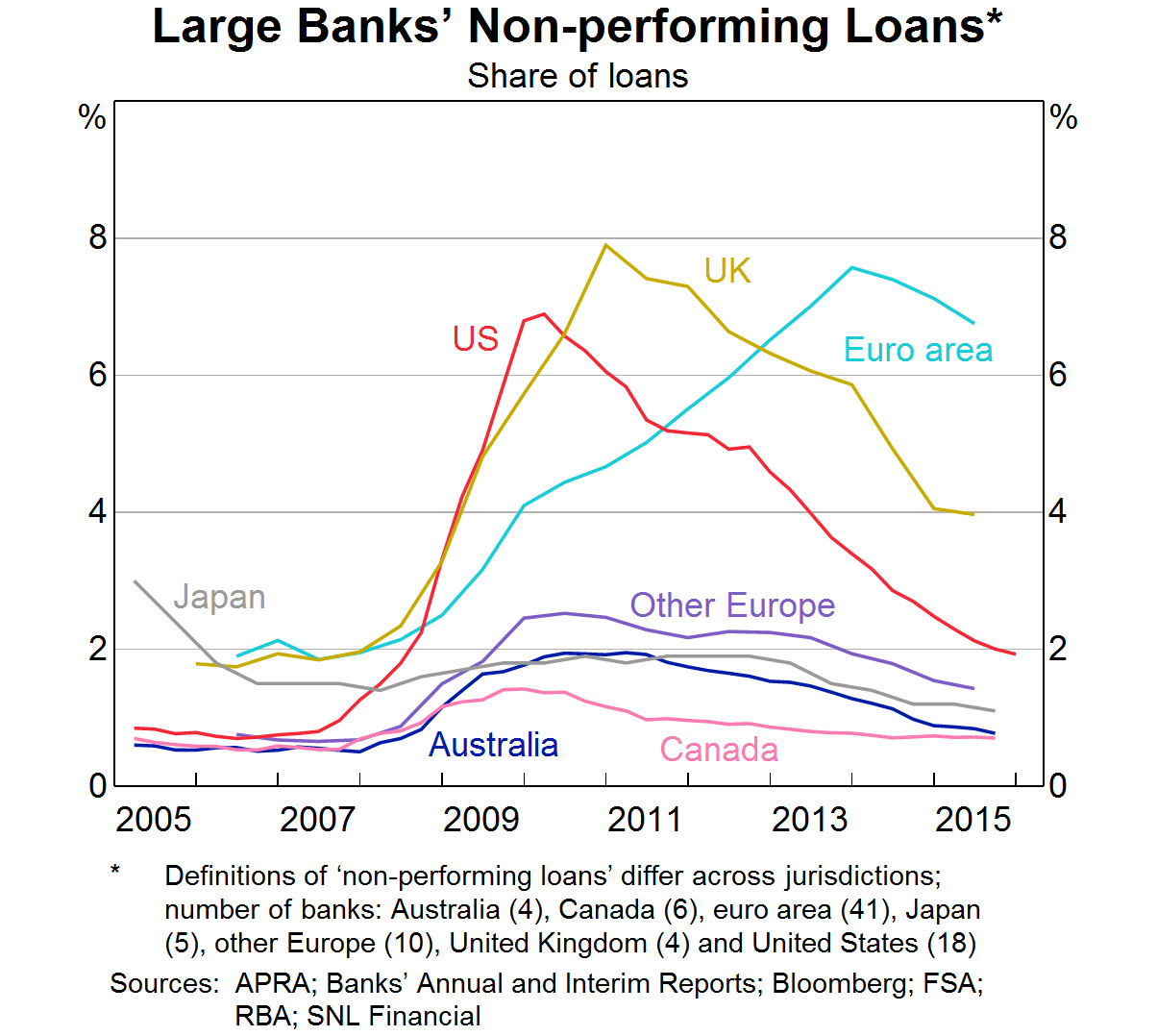
At the same time, our Review noted that financial stability risks in China have been building. The Chinese economic expansion over recent years has been associated with increasing debt, strong asset price growth and apparent overinvestment in some sectors and regions (Graph 2). If growth were to fall further from its high recent rates, past excesses might be exposed, and leverage is always harder to manage in a slower growth environment. These risks of course are hard to assess. The Chinese authorities have many levers to support growth and financial stability, given the ongoing large role of the state in the economy, the heavily regulated financial system and the presence of capital account controls. The measured central government fiscal position is also strong, though the overall public sector position is less so given the build-up in debt among local governments and state-owned enterprises.
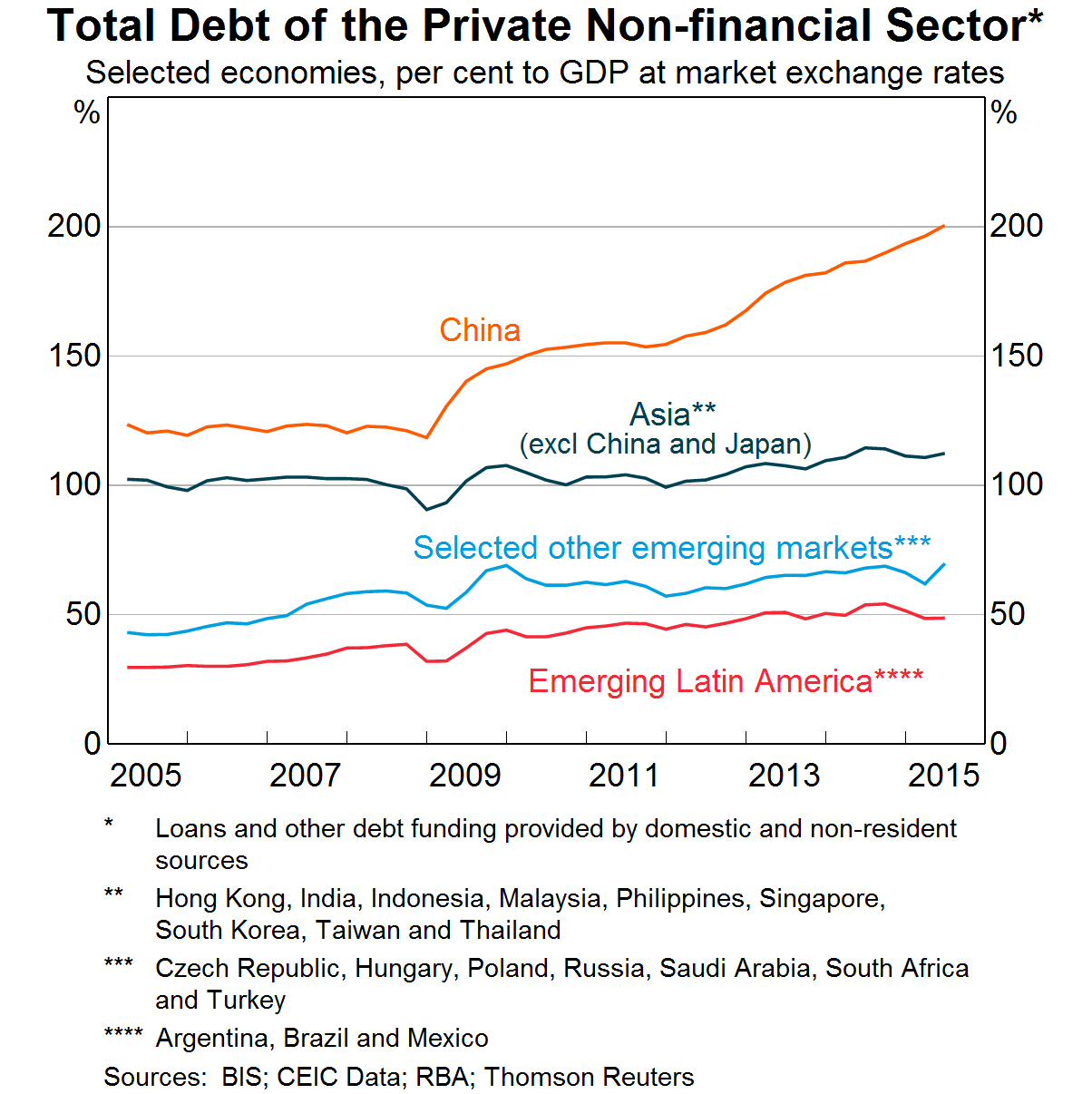
Outside China, country-specific risks also seem to have been increasing in a number of other emerging market economies – for example Brazil, Russia and Turkey. Among the various factors contributing to that have been falling commodity prices, political instability and concerns over excessive corporate leverage. In response, equity prices and exchange rates in these economies have generally fallen quite sharply. These trends were already evident through the course of last year.
These factors form part of the background to the nervousness seen in a number of markets in the early part of 2016. As I said at the outset, the early part of this year has seen some significant volatility in global markets, especially in equities and in some commodity prices. There has also been some widening in risk spreads for lower rated corporates and emerging market sovereigns. The broad equity price indices have fallen by around 10 per cent in the United States, 15 per cent in Europe, and by around 20 per cent in China since the start of the year (Graph 3). These have been accompanied by further large falls in prices of some commodities, most notably oil, continuing the declines that they had recorded over the previous couple of years (Graph 4).
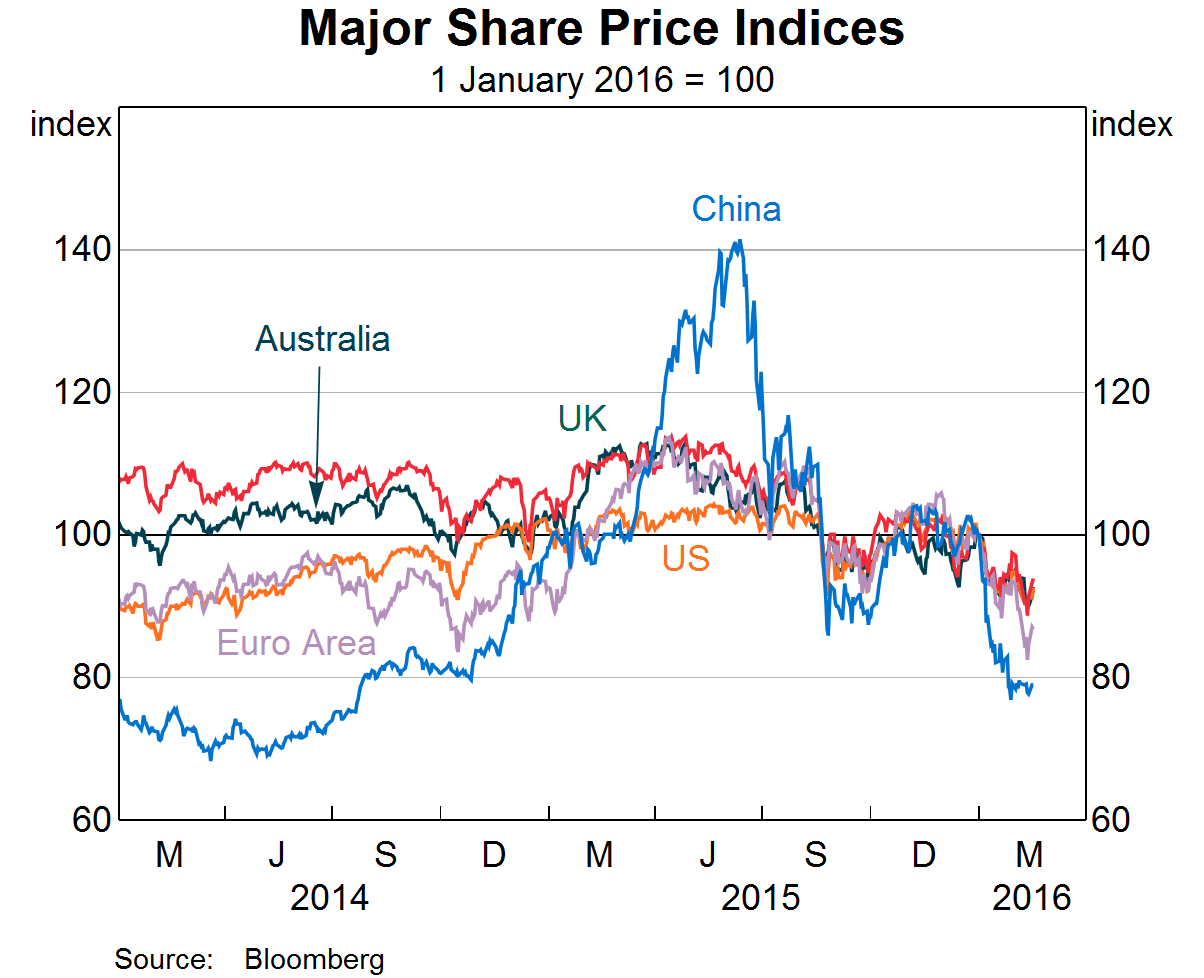
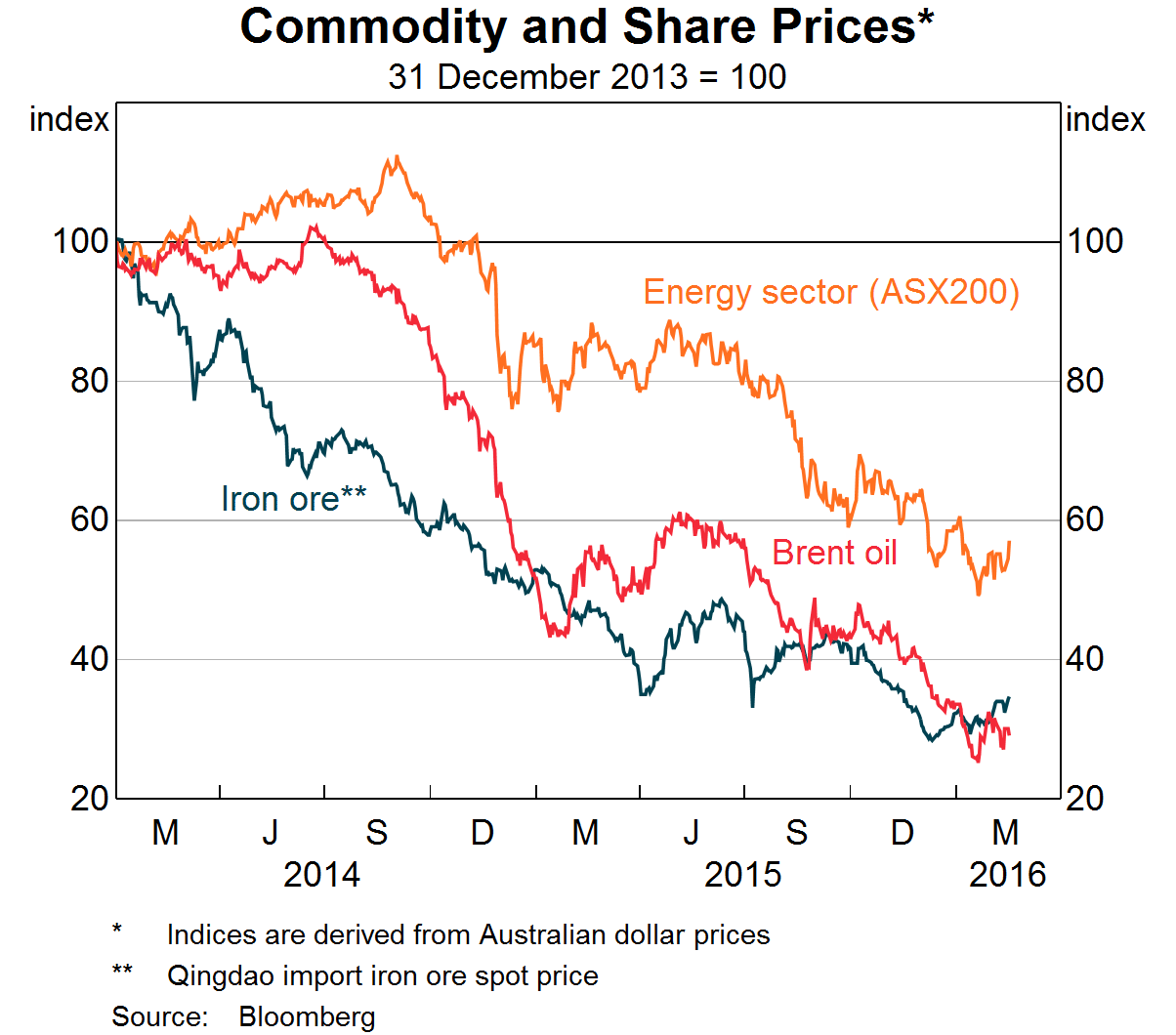
From a financial stability perspective, these developments raise a number of important questions: to what extent (if any) are these price movements inter-related, and in what way? And what, if anything, do they tell us about the evolving risk environment?
It is in the nature of these things that definitive interpretations are rarely possible, and certainly not in real time. At this stage a number of possible hypotheses might be put forward:
- the combination of lower equity and commodity prices might be signaling a weaker global outlook;
- it might simply be an indication that equity markets had previously been overvalued and in need of a correction; or
- the equity price falls might in part be an irrational response to commodity price falls and other economic data, or at least contain an element of overreaction to genuine signals.
Most likely there is an element of validity in more than one of these, and no doubt other hypotheses can be put forward as well. As I said, I don't think it is possible to be definitive about these things, but it is relevant to note that market and media commentary often errs on the side of being unjustifiably gloomy. A few points can be made on that score:
- First, as always, the recent equity price movements have to be put in perspective. This is not the first bout of nervousness in these markets: in the advanced economies there was a similar one late last year, from which markets subsequently recovered, and the recent declines reverse only a small part of the cumulative gains during the post-crisis recovery period.
- Second, there seems to have been relatively little new economic data in the early part of this year to trigger a significant reassessment of the global outlook. And even though the Chinese economy has been slowing, it is still growing at a reasonable rate.
- Third, the hypothesis that falling equity and falling oil prices are inter-related responses to a weakening in global demand is hard to sustain. The falls in oil prices seem to be mainly driven by strong supply, not weak demand, as indeed has been the case for a number of other commodities such as iron ore. Consistent with that, other non-energy commodity prices have been relatively stable during this recent period when oil prices have continued to fall. This has important implications for the general outlook. While an oil supply expansion could be expected to have a range of complicated effects on producers, consumers and holders of energy assets, it would normally be considered a net positive for the world as a whole.
I think these points argue against putting an excessive focus on recent market movements. But, that said, there has clearly been an increase in market volatility around the word in recent times and a heightened focus on financial risks.
Implications of the global risk environment for Australia
At this point it is useful to ask how these international sources of risk might affect the Australian financial system.
Direct exposures of Australian banking institutions to the risk factors I have been describing are quite limited (Table 1). Exposures to the euro area have been scaled back in the wake of the crisis and now represent only around 1 to 2 per cent of Australian banks' consolidated global assets. Although exposures to the Asian region have been growing quite rapidly over recent years, they are still a relatively small share of consolidated assets – around 4 per cent. Many of these exposures are shorter-term and trade-related, factors that should lessen credit and funding risks. That said, operational and legal risks around these exposures could be relatively high, particularly given the rapid expansion of these activities in recent times.
| Value | Share of international exposures |
Share of global consolidated assets |
|
|---|---|---|---|
| $ billion | Per cent | Per cent | |
| New Zealand | 330 | 34 | 8 |
| Asia(a) | 177 | 19 | 4 |
| – China | 46 | 5 | 1 |
| United Kingdom | 177 | 19 | 4 |
| United States | 139 | 15 | 3 |
| Europe | 66 | 7 | 2 |
| – Greece | 0 | 0 | 0 |
| Other | 67 | 7 | 2 |
| Total | 957 | 100 | 24 |
|
(a) Asia includes offshore centres Hong Kong and Singapore Sources: APRA; RBA |
|||
As a more general observation, Australian banks have increased their resilience over recent years in a number of respects, responding both to market expectations and to regulatory and supervisory actions. Notably they have raised capital ratios and shifted their funding structures to make them more resilient to financial market disruptions. Of course, none of this guarantees that Australian banks will be immune to international shocks in the future. But it suggests that the main effects from the risks I've been describing are likely to be indirect, working through the impact of factors like commodity prices, trade flows, and confidence, on the broader economy.
Domestically generated sources of risk
That brings me to the third part of our risk assessment, namely domestically generated sources of risk. Here our analysis has for some time focused on the buoyancy seen in parts of the property market and the leverage associated with that. Much of the focus has been on residential property, and I will start with that before turning to the commercial sector, where risks have also been growing.
While the housing market has not been universally strong around the country, we have seen a period of significant strength in the Sydney and Melbourne markets in recent times, with investors playing a large role. We are now seeing some easing in these pressures, as I will describe in a moment. But to summarise a few of the key facts:
- Housing prices in Sydney reached a peak annual rate of increase of 18 per cent in mid-2015.
- In Melbourne the peak rate of increase was 14 per cent around the same time.
- The value of loan approvals to investors in New South Wales approximately doubled over the two years to mid-2015.
Largely as a result of these developments, the household debt ratio has been edging up again from a level that was already high, at around 1½ times annual income (Graph 5).
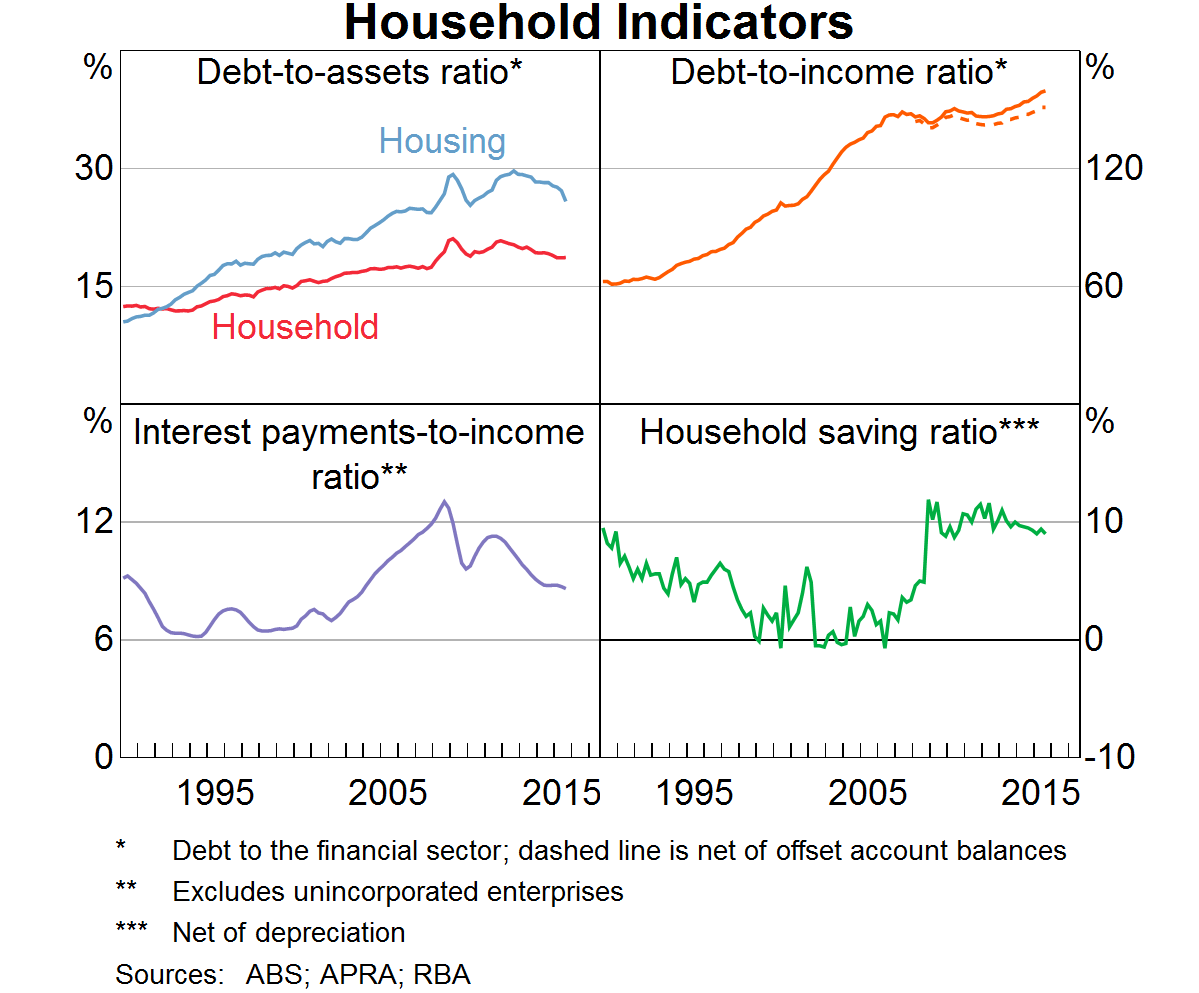
It is against this background that the Reserve Bank has highlighted the need for prudence, and has supported APRA and ASIC in the various measures that they have taken over the past few years to strengthen lending standards.
As a general proposition, mortgage lending standards in the post-crisis period have been tighter, at least more so than before the crisis. Low-doc loans are rare, genuine savings are required to fund at least part of the deposit, and the application of interest rate buffers in serviceability assessments has become widespread. Nonetheless, investigations by APRA and ASIC during 2015 showed that there had been some slipping in lending standards and that they were inadequate in some important respects to the current risk environment. Specifically, APRA found that, in some instances, lenders' serviceability assessments were based on over-optimistic judgments about the reliability of borrowers' incomes, or inadequate estimates of borrowers' living expenses, or that they failed to take into account the possible effect of future interest rate movements on a borrower's existing debt commitments. ASIC's review of interest-only lending practices made similar findings, and also noted instances where the lender did not make reasonable inquiries as to whether the loan product provided was suitable to the borrowers' circumstances.
Furthermore, as a result of the additional scrutiny over the past year and substantial data revisions made by the banks, we now know that the level of investor activity in the housing market was in fact higher than previously thought. As we have highlighted in recent Reviews, a high level of investor activity can add to the level of financial risks associated with residential markets.
As you know, APRA announced a number of supervisory measures in December 2014 to strengthen mortgage lending standards. These measures included expectations that:
- banks should not be increasing their share of higher risk lending
- growth in investor lending should not be materially above 10 per cent
- appropriate interest rate floors and buffers should be applied in serviceability assessments.
In response, lending standards tightened significantly over 2015. Interest rate buffers and floors were increased at many banks and they are now much more uniform across the sector. The level of higher risk lending has declined, notably lending with an LVR greater than 90 per cent. And the pace of investor lending growth has slowed significantly in response to a wide range of price and non-price actions that have been taken by the banks (Graph 6). This has been a welcome development given the general maturing of the current housing cycle.
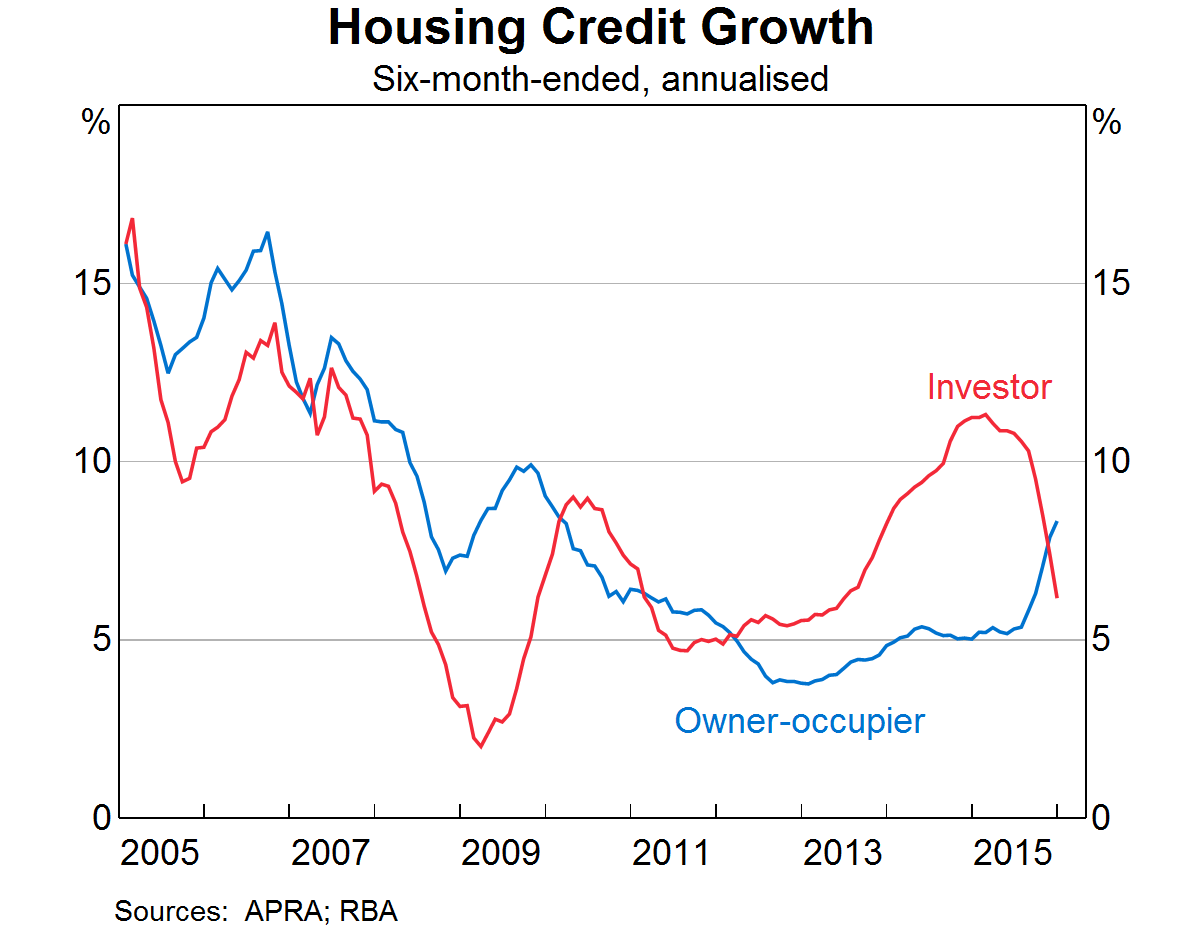
The second main area of risk focus domestically has been in commercial property. Historically this sector has been a common source of financial instability both here and abroad. During the height of the GFC, Australian banks remained in comparatively good shape but they did suffer a noticeable deterioration in asset performance, with the aggregate non-performance rate rising to just under 2 per cent of loans. A significant part of that deterioration was in their commercial property lending; impaired commercial property exposures accounted for around 30 per cent of Australian banks' non-performing domestic assets at that time.
After the post-crisis downturn, the commercial property sector is again experiencing strong investor demand, and bank lending to the sector is increasing. However, there are a number of emerging signs of increasing risk. Trends in commercial property prices and rents have been diverging over the past few years, with prices continuing to rise while rents have been flat to down (Graph 7). As a result, yields have declined. At the same time, vacancy rates have been increasing.
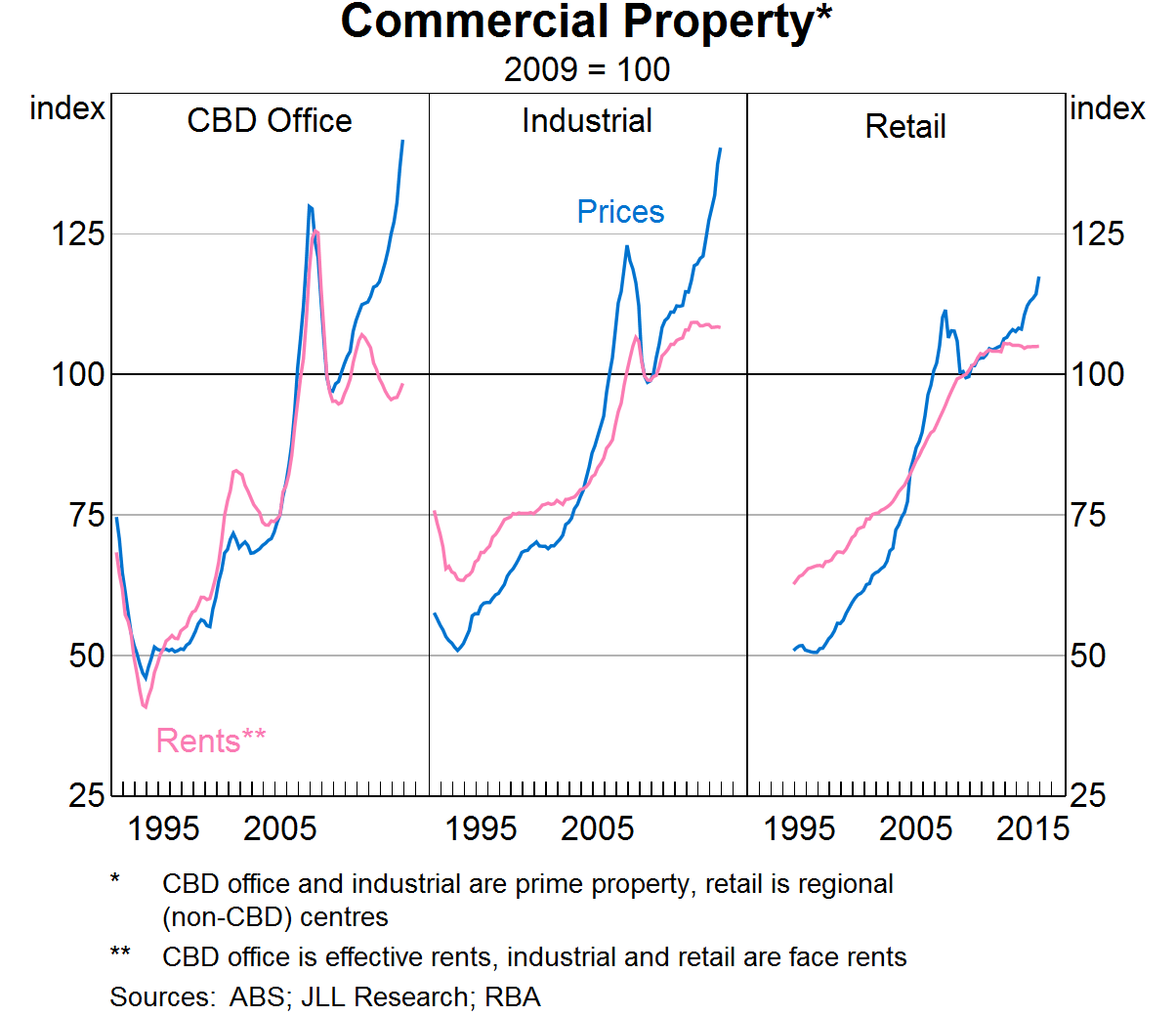
As in the housing market, conditions have not been uniform across the country, and they have been noticeably firmer in Sydney and Melbourne than in other cities. But the major commercial property markets have all seen downward pressure on yields over recent years. Strong demand from foreign buyers has contributed to this, reflecting the global environment of low interest rates and ‘search for yield’. The risks appear manageable at this stage, but they underscore the need for sound lending practices and for appropriate prudence by investors.
Concluding comments
In summing up, and to return to my original theme, the Reserve Bank has a longstanding mandate for financial stability, affirmed for example as part of the Wallis reforms in 1998. In the post-Wallis world, this has not been primarily a regulatory function. The Bank does have regulatory powers in some areas relating to financial stability, notably in its oversight of payments systems and financial market infrastructures. But the financial stability function goes well beyond that to the Reserve Bank's wider role in the financial system. It includes the Bank's role as the liquidity manager for the system and as the provider and operator of core payments infrastructure. It also includes coordination with other regulators. At a formal level, this is done through the Bank's role in chairing the Council of Financial Regulators, but there are numerous less formal channels of coordination and sharing of information and analysis. These arrangements were reviewed and supported most recently in the Murray Inquiry.
One important component of this financial stability work is the provision of timely risk analysis, to help inform the policy debate and also to help inform the decisions of lenders and investors. I have given a summary of our latest analysis today, and I hope you will find that helpful in informing your own investment decisions.
With that, I thank you for your attention, and wish you every success.
Endnotes
This is an expanded and updated version of a speech presented in November 2015. Malcom E (2015), ‘The Risk Environment and the Property Sector’, Speech at the Australian Property Institute's Queensland Property Conference, Gold Coast, 6 November. [*]
I discussed some of these issues in an earlier speech. Malcolm E (2013), ‘The Financial Stability Role of Central Banks’, Speech at the Thomson Reuters' Australian Regulatory Summit, Sydney, 1 May. [1]
Reinhart CM and K Rogoff (2009), This Time is Different: Eight Centuries of Financial Folly, Princeton University Press, Princeton. [2]